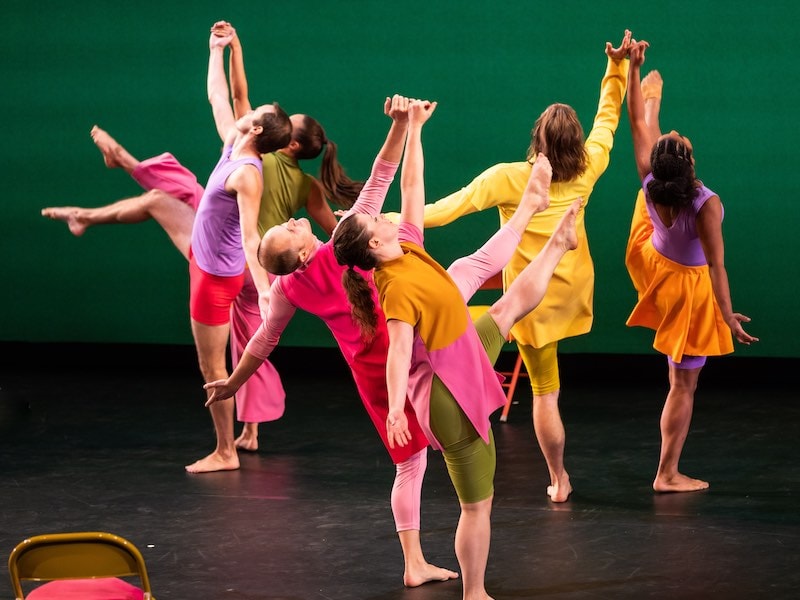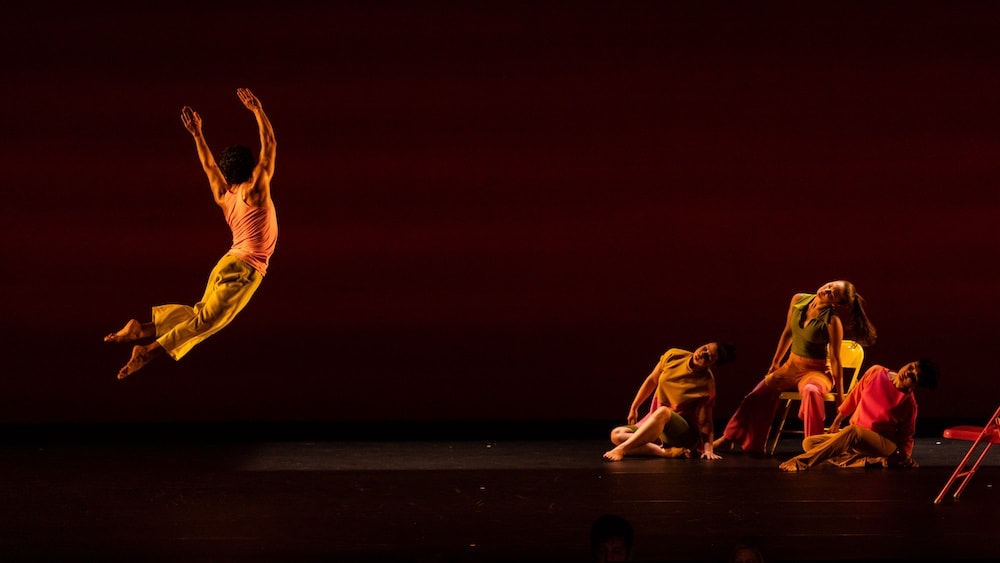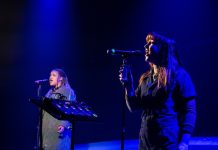One-time maverick choreographer Mark Morris is now mature enough to collect Social Security. In another millennium, way back in 1985, his Mark Morris Dance Group made its Kennedy Center debut upstairs in the Terrace Theater. Back then he had long brunette ringlets of curls, a sensitive and knowing ear for music, and a crafty way of interlacing modern dance with everything from Bach to country, East Indian raga to punk. And it worked. His young company of ten dancers exuberantly tackled the insouciant steps that were both smart and sly.
Since, Morris and his company have become institutions in the oft-precious modern dance world. He has been back to the Kennedy Center many, many times. Through Saturday, October 29, the company is ensconced at the Eisenhower with Morris’ newest work, The Look of Love, an hour-and-change work set to 1960s and ’70s pop icon Burt Bacharach’s hits.

The Look of Love comes on the heels of the company’s last Kennedy Center show in 2019, when it brought Pepperland, an easy-listening, brightly colored homage to the Beatles’ Sgt. Peppers Lonely Hearts Club Band. Back in ’85 at his first DC program, the company danced to Vivaldi, Bach, and the Violent Femmes. Nothing was experimental, but it all felt fresh, performed with frisson. Morris’ recent forays into baby boomer songbooks align well with the Broadway retreads of jukebox musicals.
Morris’ followers know well his facility with musicality and his requirement to always use live music. At the Eisenhower Theater, the company music ensemble featured music arranger and long-time MMDG collaborator Ethan Iverson on piano, and gorgeous-voiced Marcy Harriell rendering Bacharach’s songs — with most lyrics by Hal David — in thoughtful jazz renditions, with backup vocals by Clinton Curtis and Blaire Reinhard, joined by Jonathan Finlayson on trumpet, Simon Willson on bass, Vinnie Sperrazza on drums. The ensemble plays in the elevated orchestra pit, and Harriell, glamorous in her bare-shouldered dress, often turns to sing to the dancers on stage.
Raised in Forest Hills, New York, Bacharach, 94, attended the same high school as Simon and Garfunkle and Michael Landon. A child piano student, he favored jazz and later in California studied with mid-century modernist composers Henry Cowell, Bohuslav Martinu, and Darious Milhaud, whom he cites as his greatest influence. But it’s songs like “Alfie,” “I Say a Little Prayer,” “I’ll Never Fall in Love Again,” and “What the World Needs Now” that defined pop music for the 1960s and ’70s generation. Lively, singable stories of love, longing, loss, and connection, with an occasional shadow tossed in. Morris selected 14 indelible songs from the Bacharach songbook beginning with a jazzy instrumental riff on “Alfie” — surely many heard Dionne Warwick singing in their heads.
On the empty stage a few scattered folding chairs stand — one of the cliches of modern dance is the chair as a prop. It suggests the choreographer needs a device and that’s all that’s available in the rehearsal room.
The dancers enter to strains of the feel-good anthem “What the World Needs Now,” clad in sunny pastel tunics, shorts, pants, or dresses color blocked in melon-y orange, lime green, sunny yellow, ochre, and starburst pink. Morris is a master of manipulating simple movement patterns and weaving them into complex spatially shifting phrases. Fans of folk dance will recognize standard footwork featuring stomps, grapevine, and triplet steps in converging and separating lines and circular paths. Another favorite Morris-ism could be termed music visualization, when he has dancers imitate gestures that match the lyrics. It’s like he’s checking to see if we’re listening and watching enough to get his little “Easter eggs.” When the lyrics proclaim: “There are mountains and hillsides enough to climb,” in pairs, one dancer falls as another lifts an arm up — creating the base and peak of the mountain. Later, accompanying “There are sunbeams and moonbeams enough to shine,” one dancer pushes an arm upward with a one-footed hop on sun, the second follows in the other direction on moon as a raised arm indicates a moonbeam.

Next, to “I’ll Never Fall in Love Again,” on the phrase “What do you get when you kiss a guy? You get enough germs to catch pneumonia,” a little chase ensues before one dancer forces a sneeze on cue at pneumonia. Again and again, Morris has the dancers mimic the lyrics in ways that are easy, obvious, and cute. In my college choreography class this “Mickey Mousing” the music was denigrated as too simplistic. I think it’s become an easy go-to for Morris; it makes the audience feel that they “get” modern dance while letting them feel “smart.”
Morris is at his best at inventing and reshuffling dancers in evolving floor patterns here. With ten dancers moving in, shifting into duos and trios, or playing a soloist against the group his amiable locomotor walks, runs, skips, skitters, and leaps shuffle and reshuffle the landscape on stage. And all this patterning mostly jives with Bacharach’s jazzy, subtle syncopations that add interest to his standard 4/4 common time musicality.
In Harriell’s churchy rendition of “Don’t Make Me Over,” dancers flop and tumble, trying for quirky opposition, then punch a fist in the air. For “Always Something There to Remind Me,” the gesture of choice is pulling on, off, or straightening clothes, as if miming changing an outfit is enough to forget an old lover. For lovers, lost, found, wanted, and wanting are what Bacharach’s lyricist pens so adeptly.
One oddity, “The Blob,” features a dissonant clatter of horns, drums, and piano as the dancers clump together in a pile-up of chairs and limbs against Nicole Pearce’s eerie, blood-red lighting on the backdrop. At first, I thought this creepy start would morph into “What’s New Pussycat?” But, no, a quick Google search told me Bacharach actually composed the film music, and theme song, for the 1958 film The Blob. And that’s what happened: they created a blob of bodies and chairs before moving on.

The evening song cycle concluded with “I Say a Little Prayer,” and here Morris brought the company full circle, returning dancers to the opening circle, as they intersect in a bit of a basket weave. Some now-expected goofy movements — dancers’ arms flapping like wings of graceless angels, as they parse out a pony-like bounce — garner a laugh or two. Then a lexicon of the gestural motifs is recapitulated as the company, two-by-two, one-by-one, makes their way off stage, leaving a lone dancer to exit. The Look of Love ends not on a high note, a bright note, or even a grace note, but on a breathy “Amen.” It’s like a sigh — of relief, of longing, of completion, perhaps. But it feels inadequate, even incomplete.
Throughout, the dancers adeptly work through Morris’ signature paces, but for the most part, they don’t project any particular deep feeling to the movement, the music, or even one another. Sometimes they were just going through their paces rather than reveling in the music visualizations. It’s as if they’re still looking — for inspiration, for ways to fully love and embrace this new work. And it’s a shame because the musicianship of the ensemble should draw these dancers in, but they haven’t fully committed themselves to loving The Look of Love.
Running Time: One hour 5 minutes, no intermission.
The Look of Love by Mark Morris Dance Group plays through October 29, 2022, in the Eisenhower Theater in the John F. Kennedy Center for the Performing Arts Opera House, 2700 F Street NW, Washington, DC. Tickets ($29–$119) are available at the box office, online, or by calling (202) 467-4600 or (800) 444-1324.
The program for The Look of Love is online here.
COVID Safety: Masks are optional in all Kennedy Center spaces for visitors and staff. If you prefer to wear a mask, you are welcome to do so. See Kennedy Center’s complete COVID Safety Plan here.




